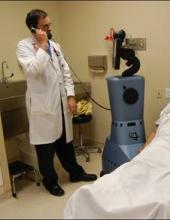GRAPEVINE, TX – In its first year of operation, a hospitalist-created telemedicine stroke center has reported patient outcomes – including timely thrombolytic therapy and mortality – that are at least as good as those seen among all such centers included in the American Stroke Association’s database.
Dr. Karim B. Godamunne, founder and medical director of the Certified Advanced Primary Stroke Center at South Fulton Medical Center, East Point, Ga., presented the center’s first-year outcomes at the annual meeting of the Society for Hospital Medicine.
South Fulton is an predominately black community near Atlanta that is medically underserved, with a shortage of neurologists and experts in stroke care, but rich in patients with an increased stroke risk said Dr. Godamunne, who is also director of hospital medicine there. "We needed some kind of way to provide good stroke care for our patients."
An attempt to create a stroke center at South Fulton several years ago failed, he said in an interview, mainly because most neurologists in the area work only in outpatient settings. After creating the hospitalist program at South in 2007, Dr. Godamunne was ready to try implementing a new concept – combining the clinical expertise of hospitalists and telemedicine to build a stroke center
In 2009, the American Stroke Association consensus statement found telemedicine an excellent way to improve stroke care, especially in underserved areas or when a neurologist is not available in the hospital.
South Fulton seemed like a perfect fit for this treatment paradigm. Working closely with Eagle Hospital Physicians of Atlanta and South Fulton Medical Center, Dr. Godamunne installed a telemedicine unit that provides a live video link with stroke specialists, who are available around the clock. The telestroke unit has a wheeled computer workstation with a two-way video camera and microphone, a large display screen, and a wireless Internet connection. The remote physician operates it from a laptop equipped with a joystick, moving the camera and video screen up, down, and side to side. The system also allows the entire unit to roll unassisted through the hall and into a patient’s room
It can be equipped with a stethoscope, which a bedside attending or a nurse use normally, while the remote physician sees and hears the information detected. Remote physicians can examine the patient almost as if they were in the room, said Dr. Godamunne, who is also who is also the vice-president of clinical systems integration for Eagle Hospital Physicians. The system allows for faster decision making at a critical time, he said. However, he added, a robot – even one with a neurologist manning it – can’t completely replace the bedside clinician: "In-house neurology coverage is still essential, but by leveraging telemedicine and hospitalists, we can build a stroke center with far fewer neurologists than previously required.
"Treating stroke isn’t just about giving thrombolytics, but preventing hospital complications like pneumonia and deep-vein thrombosis, and discharging patients on medical therapies that can prevent a subsequent stroke."
"The key part in developing this type of telestroke system is that you must have a physician in-house to coordinate other aspects of care," Dr. Godamunne said. "This is where the hospitalist comes in. We issue the orders based on the ‘Get With the Guidelines’ criteria and put all the protocol into one place."
Hospitalists improved their expertise in managing stroke patients through training, operational procedures, protocol development and collaboration with the teleneurologists.
After 6 months of use, South Fulton’s integrated hospitalist telestroke program earned the Joint Commission’s certification as an Advanced Primary Stroke Center. Within a year, it had received American Stroke Association’s Silver Plus status – the highest honor achievable for a first-year stroke program.
To examine the program’s effectiveness, Dr. Godamunne compared its 1-year outcomes with those of patients treated during the same time, recorded in the "Get With the Guidelines" database. The study compared length of stay and mortality, and also eight primary stroke center score measures:
- DVT prophylaxis by day 2.
- Antithrombotic therapy at discharge.
- Anticoagulation therapy for ischemic stroke patients who have atrial fibrillation/flutter.
- Tissue plasminogen activator given within 2 hours of hospital arrival and 3 hours of onset.
- Antithrombotic therapy by day 2 of admission.
- Statins for patients with high low-density lipoprotein cholesterol.
- Stroke education for patients and their caregivers.
- Patient assessment for rehabilitation.
Over the first year, hospitalists cared for 70% (168) of the 240 patients admitted for possible stroke at the South Fulton telestroke center; 158 of these were discharged with a diagnosis of stroke – a 75% increase over the previous year.


